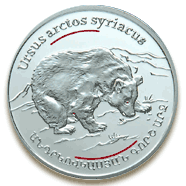Syrian brown bear
| Syrian brown bear | |
|---|---|
 | |
| Conservation status | |
| Scientific classification | |
| Kingdom: | Animalia |
| Phylum: | Chordata |
| Class: | Mammalia |
| Order: | Carnivora |
| Family: | Ursidae |
| Genus: | Ursus |
| Species: | U. arctos |
| Subspecies: | U. a. syriacus |
| Trinomial name | |
| Ursus arctos syriacus Hemprich & Ehrenberg, 1828 | |
 | |
| Synonyms | |
|
caucasicus Smirnov, 1919 | |
The Syrian brown bear (Ursus arctos syriacus) is a relatively small subspecies of brown bear native to Eurasia.
Distribution
Within the former Soviet Union, it occurs in Transcaucasia, notably in Azerbaijan, Armenia, Georgia and Turkmenistan.[1] Outside the ex-USSR, it occurs in Iran, Iraq and Turkey.[2][3] It is extinct in Israel, Lebanon and, more recently, in Syria.[2]
Like many large mammals, the Syrian brown bear population is declining due to habitat loss, and poaching. They are a popular target for big game hunters in the Middle East and in Asia.[4] In addition, bear bile (ursodeoxycholic acid) is a valuable commodity because of its use in traditional Chinese medicine as an assumed cure for rheumatism, poor eyesight and gall stones.[5]
Description
It is one of the smaller subspecies of brown bears, although brown bears as a group are among the largest type of bears, second only to polar bears. Adult males have skulls measuring approximately 30–40 cm. Fur color is usually very light brown and straw coloured. The hair on the withers is longer with a grey-brown base and is often a different shade then the rest of the body, seen in some individuals as a dark stripe running across the back. Individuals from the middle and Western Caucasus, whose ranges overlap those of Eurasian brown bears, are darker in colour, and larger in size, leading some naturalists to propose that they are in fact hybrid populations of Eurasian and Syrian brown bears. It is thought that these mixed bears originated during the Holocene when Syrian bears migrated Northward and interbred with the larger Northern bears. These populations have skulls measuring 37–40 cm in length, and their fur colour is reddish brown with no mixture of black and brown tones.[1]
Habitat
Generally found in the mountainous areas throughout its home range, the Syrian brown bears seem to den and hibernate in caves and tree hollows of the birch forests, which are found at higher elevations than pine and other trees. Outside of hibernation these bears tend to forage for food in grasslands, meadows, forests and have been known to enter mountain villages to feed on grains and nuts.[6]
Culture

Wojtek
Among the huge variety of troops serving at Monte Cassino, probably the strangest was a bear from Iran, called Wojtek. Raised by and enlisted into the 22nd Artillery Supply Company of the Polish II Corps, he carried artillery shells during battle.
References
- ↑ 1.0 1.1 Mammals of the Soviet Union Vol.II Part 1a, SIRENIA AND CARNIVORA (Sea cows; Wolves and Bears), V.G Heptner and N.P Naumov editors, Science Publishers, Inc. USA. 1998. ISBN 1-886106-81-9
- ↑ 2.0 2.1 Genetic diversity of endangered brown bear (Ursus arctos) populations at the crossroads of Europe, Asia and Africa. (PDF) . Retrieved on 2011-09-26.
- ↑ The Mammals of Iraq. (PDF) . Retrieved on 2011-09-26.
- ↑ Первый американский русскоязычный интернет-магазин товаров для охотников. Russianbearhunt.com. Retrieved on 2011-09-26.
- ↑ GALL and the BILE inside. Arktofile.net. Retrieved on 2011-09-26.
- ↑ Lydekker, R. 1996. The Great and Small Game of India, Burma, and Tibet. Asian Educational Services.
External links
| Wikimedia Commons has media related to Ursus arctos syriacus. |
| Wikispecies has information related to: Ursus arctos syriacus |
- Syrian brown bear camera trap footage in the Caucasus Wildlife refuge, Armenia from World Land Trust
